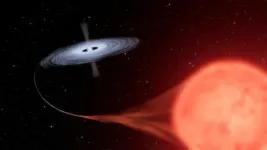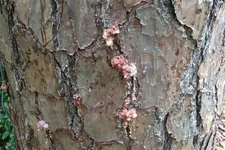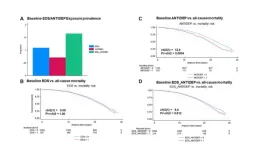(Press-News.org) Astronomers have used new data from NASA's Hubble Space Telescope and the retired SOFIA (Stratospheric Observatory for Infrared Astronomy) as well as archival data from other missions to revisit one of the strangest binary star systems in our galaxy – 40 years after it burst onto the scene as a bright and long-lived nova. A nova is a star that suddenly increases its brightness tremendously and then fades away to its former obscurity, usually in a few months or years.
Between April and September 1975, the binary system HM Sagittae (HM Sge) grew 250 times brighter. Even more unusual, it did not rapidly fade away as novae commonly do, but has maintained its luminosity for decades. Recently, observations show that the system has gotten hotter, but paradoxically faded a little.
HM Sge is a particular kind of symbiotic star where a white dwarf and a bloated, dust-producing giant companion star are in an eccentric orbit around each other, and the white dwarf ingests gas flowing from the giant star. That gas forms a blazing hot disk around the white dwarf, which can unpredictably undergo a spontaneous thermonuclear explosion as the infall of hydrogen from the giant grows denser on the surface until it reaches a tipping point. These fireworks between companion stars fascinate astronomers by yielding insights into the physics and dynamics of stellar evolution in binary systems.
"In 1975 HM Sge went from being a nondescript star to something all astronomers in the field were looking at, and at some point that flurry of activity slowed down," said Ravi Sankrit of the Space Telescope Science Institute (STScI) in Baltimore. In 2021, Steven Goldman of STScI, Sankrit and collaborators used instruments on Hubble and SOFIA to see what had changed with HM Sge in the last 30 years at wavelengths of light from the infrared to the ultraviolet (UV).
The 2021 ultraviolet data from Hubble showed a strong emission line of highly ionized magnesium that was not present in earlier published spectra from 1990. Its presence shows that the estimated temperature of the white dwarf and accretion disk increased from less than 400,000 degrees Fahrenheit in 1989 to greater than 450,000 degrees Fahrenheit now. The highly ionized magnesium line is one of many seen in the UV spectrum, which analyzed together will reveal the energetics of the system, and how it has changed in the last three decades.
"When I first saw the new data," Sankrit said, "I went – 'wow this is what Hubble UV spectroscopy can do!' – I mean it's spectacular, really spectacular."
With data from NASA's flying telescope SOFIA, which retired in 2022, the team was able to detect the water, gas, and dust flowing in and around the system. Infrared spectral data shows that the giant star, which produces copious amounts of dust, returned to its normal behavior within only a couple years of the explosion, but also that it has dimmed in recent years, which is another puzzle to be explained.
With SOFIA astronomers were able to see water moving at around 18 miles per second, which they suspect is the speed of the sizzling accretion disk around the white dwarf. The bridge of gas connecting the giant star to the white dwarf must presently span about 2 billion miles.
The team has also been working with the AAVSO (American Association of Variable Star Observers), to collaborate with amateur astronomers from around the world who help keep telescopic eyes on HM Sge; their continued monitoring reveals changes that haven't been seen since its outburst 40 years ago.
"Symbiotic stars like HM Sge are rare in our galaxy, and witnessing a nova-like explosion is even rarer. This unique event is a treasure for astrophysicists spanning decades," said Goldman.
The initial results from the team's research were published in the Astrophysical Journal, and Sankrit is presenting research focused on the UV spectroscopy at the 244th meeting of the American Astronomical Society in Madison, Wisconsin.
The Hubble Space Telescope has been operating for over three decades and continues to make ground-breaking discoveries that shape our fundamental understanding of the universe. Hubble is a project of international cooperation between NASA and ESA (European Space Agency). NASA's Goddard Space Flight Center in Greenbelt, Maryland, manages the telescope and mission operations. Lockheed Martin Space, based in Denver, Colorado, also supports mission operations at Goddard. The Space Telescope Science Institute in Baltimore, Maryland, which is operated by the Association of Universities for Research in Astronomy, conducts Hubble science operations for NASA.
Explore More:
Three-Year Study of Young Stars with NASA’s Hubble Enters New Chapter
Hubble Views the Dawn of a Sun-like Star
Hubble Sees New Star Proclaiming Presence with Cosmic Lightshow
NASA’s Hubble Finds that Aging Brown Dwarfs Grow Lonely
@NASAHubble
@NASAHubble
@NASAHubble
Media Contacts:
Claire Andreoli
NASA's Goddard Space Flight Center, Greenbelt, MD
claire.andreoli@nasa.gov
Ray Villard
Space Telescope Science Institute, Baltimore, MD
Science Contacts:
Ravi Sankrit
Space Telescope Science Institute, Baltimore, MD
Steven Goldman
Space Telescope Science Institute, Baltimore, MD
END
Hubble finds surprises around a star that erupted 40 years ago
2024-06-10
ELSE PRESS RELEASES FROM THIS DATE:
NASA’s Webb opens new window on supernova science
2024-06-10
Peering deeply into the cosmos, NASA’s James Webb Space Telescope is giving scientists their first detailed glimpse of supernovae from a time when our universe was just a small fraction of its current age. A team using Webb data has identified 10 times more supernovae in the early universe than were previously known. A few of the newfound exploding stars are the most distant examples of their type, including those used to measure the universe's expansion rate.
"Webb is a supernova ...
May research news from the Ecological Society of America
2024-06-10
The Ecological Society of America (ESA) presents a roundup of four research articles recently published across its six esteemed journals. Widely recognized for fostering innovation and advancing ecological knowledge, ESA’s journals consistently feature illuminating and impactful studies. This compilation of papers explores how wolf reintroduction affects other carnivores, how drought and grazing snails together drive salt marsh productivity, the key to an invasive fish’s success and the plight of backyard trees, ...
Taking the fall: How stunt performers struggle with reporting head trauma
2024-06-10
In the heart-pounding action scenes of your favorite blockbuster, it's not always the A-list actor taking the risks but the unsung heroes—stunt performers—who bring those breathtaking moments to life. However, behind the glamour lies a grim reality: the reluctance of these daredevils to report head trauma, fearing it could jeopardize their careers.
In the recently released blockbuster, “The Fall Guy,” audiences get a behind-the-scenes look at what stunt professionals go through to create those most thrilling moments, and although this film celebrates these skilled professionals, it does not highlight the impact the stunts can have on their health.
Ohio ...
Income inequality and carbon dioxide emissions have a complex relationship
2024-06-10
Income inequality and carbon dioxide emissions for high-income nations such as the United States, Denmark and Canada are intrinsically linked – but a new study from Drexel University has taken a deeper look at the connection and found this relationship is less fixed, can change over time, and differ across emission components. The findings could help countries set a course toward reducing emissions of the harmful greenhouse gas and alleviating domestic income inequality at the same time.
The ...
Yuan elevated to IEEE senior member
2024-06-10
Jinghui Yuan, an R&D staff member in the Applied Research for Mobility Systems group at the Department of Energy’s Oak Ridge National Laboratory, has been elevated to a senior member of the Institute of Electrical and Electronics Engineers, or IEEE.
Senior member status is the highest grade of IEEE and requires extensive experience that reflects professional accomplishments. Only 10% of IEEE’s more than 450,000 members achieve this level.
As a transportation engineer in the Buildings and Transportation Science Division, Yuan’s research focuses on intelligent transportation systems, crash risk prediction, big data analytics, deep learning, traffic simulation and ...
Passive heat exposure increases stress on the heart, posing risk to adults with history of CAD
2024-06-10
Embargoed for release until 5:00 p.m. ET on Monday 10 June 2024
Annals of Internal Medicine Tip Sheet
@Annalsofim
Below please find summaries of new articles that will be published in the next issue of Annals of Internal Medicine. The summaries are not intended to substitute for the full articles as a source of information. This information is under strict embargo and by taking it into possession, media representatives are committing to the terms of the embargo not only on their own behalf, but also on behalf of the organization they represent.
----------------------------
1. ...
Feeling rough after your COVID shot? Congrats, it’s working!
2024-06-10
Feeling Rough After Your COVID Shot? Congrats, It’s Working!
Headache, chills, tiredness may be evidence of a supercharged defense, according to UCSF-led study.
Fewer than 1 in 4 people in the United States have received last year’s updated COVID-19 vaccine, despite a death toll of more than 23,000 Americans this year.
One of the most common reasons for bypassing the COVID vaccine is concern about side effects like tiredness, muscle and joint pain, chills, headache, fever, nausea and feeling generally unwell. But a new study, led by UC San Francisco, has found that the symptoms indicate a robust immune response that is likely to ...
Depression, antidepressants, epigenetic age acceleration, and mortality in postmenopausal women
2024-06-10
“The study examined the impact of depressive symptoms, antidepressant use, and epigenetic age acceleration on all-cause mortality in postmenopausal women.”
BUFFALO, NY- June 10, 2024 – A new research paper was published in Aging (listed by MEDLINE/PubMed as "Aging (Albany NY)" and "Aging-US" by Web of Science) Volume 16, Issue 10, entitled, “Relationships of depression and antidepressant use with epigenetic age acceleration and all-cause mortality among postmenopausal women.”
In this new study, researchers May A. Beydoun, Hind A. Beydoun, Jason Ashe, Michael F. Georgescu, Steve Horvath, Ake Lu, Anthony S. Zannas, ...
Researchers engineer new approach for controlling thermal emission
2024-06-10
UNIVERSITY PARK, Pa. — If a material absorbs light, it will heat up. That heat must go somewhere, and the ability to control where and how much heat is emitted can protect or even hide such devices as satellites. An international team of researchers, including those from Penn State, has developed a novel method for controlling this thermal emission, with what they called promising implications for thermal management and thermal camouflage technologies.
The team published their work on June 7 in the print edition of Science.
Led by researchers at The University of Manchester’s National Graphene Institute ...
UTA honors two faculty for distinguished scholarship
2024-06-10
The University of Texas at Arlington is honoring two faculty for their outstanding contributions to scholarship with the Distinguished Record of Research or Creativity Award.
Sam W. Haynes, professor of history, and Jaehoon Yu, professor of physics, are the 2024 recipients of the award, which recognizes faculty who have achieved a distinguished record of scholarship over an extended period.
“Jae and Sam have each been at UTA for more than 20 years, and they have each truly made an impact in the lives of the students we prepare for future careers,” said Kate C. Miller, vice president of research and innovation. "In addition, their contributions ...








